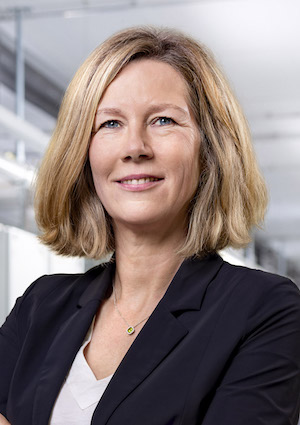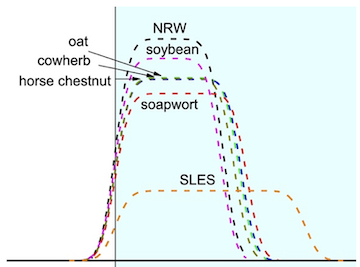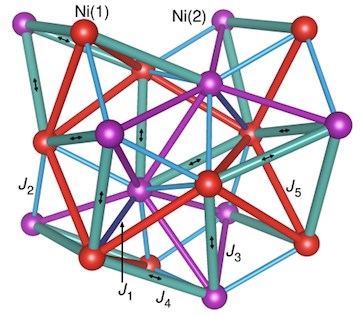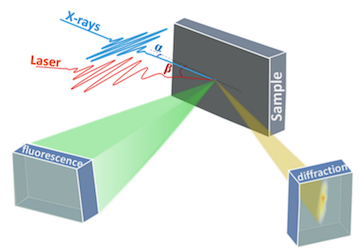|
|
Dear Colleagues
It has become customary over the last two years to begin this editorial talking about the pandemic. This will now be the eighth editorial (since a joyful Adrian Cavalieri looked to the year ahead in December 2019), where the pandemic forms a backdrop to many of the things we do, not least in the way we interact with each other. Yet, here in communications, 2021 has been a colourful year of exciting changes and I would like to tell you about some of these.
|

Mirjam van Daalen
|
|
One of the major changes we are making is in our peer-to-peer communications: how we communicate the incredible – and diverse – research taking place here at PSI with the global scientific community. We want to broaden the reach of our research output beyond the immediate disciplinary peers. This will foster new, interdisciplinary ideas and new collaborations. We want to inform potential users from a wider base of what can be achieved using the world-leading facilities available at PSI.
You may have noticed that we have a new, dedicated science landing page. Here, you will find frequently changing highlights of our research, aimed at a broad scientific audience. These stories may be of ground-breaking fundamental research, or of research that is important to share because it has wide-reaching applications. I hope you will find these stories stimulating.
We would like to have a more open dialogue with peers, communicating the research that will interest you, excite you and stimulate ideas. Interact with us on social media, particularly on Twitter and LinkedIn. Follow our stories, share your ideas or applications with us, start a discussion! If you share publications done at or in collaboration with PSI, please let us know and we can improve the reach of them – you can use the Twitter handle @psich_en or hashtag #ResearchAtPsi.
Communication may not always be the first thing on your mind during a long night shift collecting data. But making the effort beyond publication to share your findings is about doing justice to those night shifts. In these days without poster sessions mingling at conferences, discussions in the coffee room or Christmas parties, this has never been more important.
Personally, especially as new head of PSI communications, I look forward to interacting with you more in 2022.
Festive greetings,
Mirjam van Daalen
Head - Communications, PSI
|
|
Next proposal submission deadlines:
CHRISP
deadline: January 10, 2022
more information
SwissFEL
deadline: March 15, 2022
more information
SLS: non-PX beamlines
deadline: March 15, 2022
more information
SLS: PX beamlines
deadline: April 15, 2022
more information
SINQ
deadline: May 15, 2022
more information
SµS
deadline: June 2022
more information
An overview of all proposal submission deadlines of the PSI facilities can be found here.
|
|
|
Tuning the Berry curvature in 2D perovskite polaritons
 SLS — A handle on topology SLS — A handle on topology
In recent years, exciton–polariton systems, in which excitons and photons can be strongly coupled, have been establishing as a versatile platform for realizing topological states, a topic of great current interest. Now an international team of researchers demonstrated that one such system offers particularly intriguing capabilities — 2D perovskite crystals (which were characterized at the PXIII beamline of SLS) embedded in a planar microcavity. In these samples not only could they determine different Berry curvatures, an entity of key importance in topological physics. They were also able to actively change the Berry curvature distribution by varying temperature and external magnetic fields. This raises the prospect of exploring topological states in a system that can be tuned without the need of complex fabrication techniques and, importantly, can operate at room temperature.
|
|
|
L. Polimeno et al., Nature Nanotechnology 16, 1349 (2021)
|
|
|
Effect of surface-active extracts from saponin-rich plants on lipid layers
 SINQ — Looking under the skin SINQ — Looking under the skin
Plant extracts have always had an important role in human civilization, and even if today synthetic analogues exist for many of the chemicals involved, the plant-derived ‘originals’ remain often superior in various aspects. One example are biosurfactants derived from plants rich in saponin, such as soybeans or oat. These extracts are used increasingly in natural cosmetics, so the question arises how they affect human skin. To test this, an international team carefully extracted powders from a range of saponin-rich plants and examined their effect on lipid mono- and bilayers, mimicking human skin layers. Among the analytical tools used was the neutron reflectometer AMOR at SINQ, where they explored the structure of the penetrated lipid layers. The overall picture that emerged is encouraging: at least for the skin models used, the extracts have no significant effect on the lipid layers.
|
|
|
K. Wojciechowski et al., Surfaces and Interfaces 27, 101486 (2021)
|
|
|
Magnetic-field-induced quantum spin liquid in coupled trillium lattices
 SμS — Inspiringly frustrated SμS — Inspiringly frustrated
Quantum spin liquids (QSLs) are intriguing states of strongly correlated systems in which spins avoid long-range order and are considered entangled on all spatial scales. Realizing QSLs is challenging, and particularly so in 3D systems. Now an international team of researchers has introduced an exciting new member to the family of 3D QSLs, in the form of K 2Ni 2(SO 4) 3. In neutron-scattering and muon-spin-relaxation experiments — the latter performed at the LTF and GPS beamlines of SμS and at ISIS (UK) — combined with density functional theory calculations, they established that this material features a peculiar arrangement of spins forming two interconnected trillium lattices. Unlike in single trillium lattices, in the case of two coupled lattices the spins exhibit a level of frustration that, as the team shows, is sufficient that a magnetic field can drive the system into a pure QSL state.
Read the full story |
|
|
I. Živković et al., Physical Review Letters 127, 157204 (2021)
|
|
|
Ultrafast electron localization in a correlated metal
 SwissFEL — How to catch an electron SwissFEL — How to catch an electron
When a material is excited with an intense femtosecond laser pulse, electrons are ejected from the atoms during exposure. This is well known and extensively employed to solve protein crystal structures at XFELs. However, how and how fast electrons can be captured by an ion — that is, added into a localized shell — remains largely unclear. Now an international team contributed to filling this gap in knowledge by studying a correlated electron material with state-of-art pump–probe techniques. Working at the Bernina instrument of SwissFEL, they were able to quantify the number of electrons that get localized on an ultrafast timescale out of an electron gas into 4f states. The electron localization was found to strongly impact the crystal structure as well, opening up questions that are likely to impact our fundamental understanding of electron correlations and their coupling to the lattice.
Read the full story |
|
|
J. R. L. Mardegan et al., Physical Review Research 3, 033211 (2021)
|
|
|
Science case for the new High-Intensity Muon Beams at PSI
 CHRISP — A strong case for a groundbreaking project CHRISP — A strong case for a groundbreaking project
The preparations for the High-Intensity Muon Beams (HIMB) project have taken a further important step with the completion of the science case. With an intensity of 10 10 surface muons per second, entirely new experiments with considerable discovery potential and unique sensitivities will be possible. Ideas and concrete proposals initially collected during a workshop in April this year were further substantiated over the following months and assembled in a comprehensive document of more than 100 pages, which is now publicly available on the arXiv preprint repository. More than thirty authors from Europe and Japan contributed to this unique programme. HIMB will secure a worldwide leading position in fundamental and applied muon science, and is set to attract in the coming decades numerous national and international user groups to PSI. |
|
|
M. Aiba et al., arXiv: 2111.05788 (2021)
|
|
|
News from the user facilities
|
|
|
X-ray microscopy with 1000 tomograms per second
SLS
A new world record has been set at SLS, were a team led by scientists from the Helmholtz-Zentrum Berlin has demonstrated time-resolved X-ray tomography at a rate of 1000 tomograms per second, while maintaining spatial resolutions of micrometres and running experiments for minutes without interruption. With these newest experiments, the team has bettered their own former record by a factor of five — thus further boosting the capabilities of the so-called ‘tomoscopy’ method.
More information |
|
New equipment for sample environment
SINQ
We have recently commissioned a new cryo-magnet for research under multi-extreme conditions at SINQ/PSI. The system consists of a 11 T vertical field magnet and a powerful dilution refrigerator that can be combined with various clamp pressure cells. Currently, we can offer pressures of up to 8 kbar in the temperature range from 40 mK up to room temperature and in a magnetic fields up to 11 T. For pressure experiments at zero magnetic field, the clamp cells currently available in the user programme and the dilution refrigerator can be operated with a compatible helium cryostat. The system can be operated on the single-crystal diffractometer ZEBRA as well as on the spectrometers, TASP, EIGER and CAMEA. For a more detailed planning consult the links below and do not hesitate to contact us.
More information on Cryomagnets, Mounting interfaces
In addition to our dilution refrigerator inserts, we now offer a 3He insert for ultra-low-temperature experiments. The device is characterized by a short cool-down time and ease of operation, more details. |
|
Strong request for SμS beam time
SμS
A total of 172 new proposals were submitted at the recent submission deadline in early December. Most of the beamtime applications were submitted for the GPS instrument (62) followed by DOLLY (48) and LEM (25). Together with the 83 proposals from the previous deadline in June that amounts to 255 new SμS proposals in 2021 - a strong indication for the ongoing urgent need for muon beamtime at PSI.
The review panel will meet in early February 2022 and we aim to inform the users as soon as possible about the result of the evaluation.
|
|
A compact X-ray FEL using the optical klystron effect
SwissFEL
A SwissFEL team has demonstrated the operation of a compact X-ray free-electron laser (FEL) using the optical klystron mechanism. In experiments at the Athos soft X-ray beamline, they showed that the effect speeds up the FEL process using the dispersion of magnetic chicanes placed between the undulator modules of the FEL beamline. Compared to standard operation without chicanes, the required undulator length to achieve FEL saturation was found to be reduced between 15% and 30% for radiation wavelengths between 1 and 2 nm.
More information |
|
Silver medal at the EuroSkills competition
CHRISP
PSI electronics technician Mario Liechti secured a silver medal at the EuroSkills competition for young professionals, which took place in September in Graz (Austria). Liechti received his vocational training in the Electronics Education and Service Pool at PSI that is embedded in the Laboratory for Particle Physics, which also operates the user facility CHRISP. Having won already a gold medal at the national SwissSkills competition in 2020, he was now again on the podium, this time at the EuroSkills, where he came second in the ‘electronic prototyping’ contest.
More information |
|
|
|